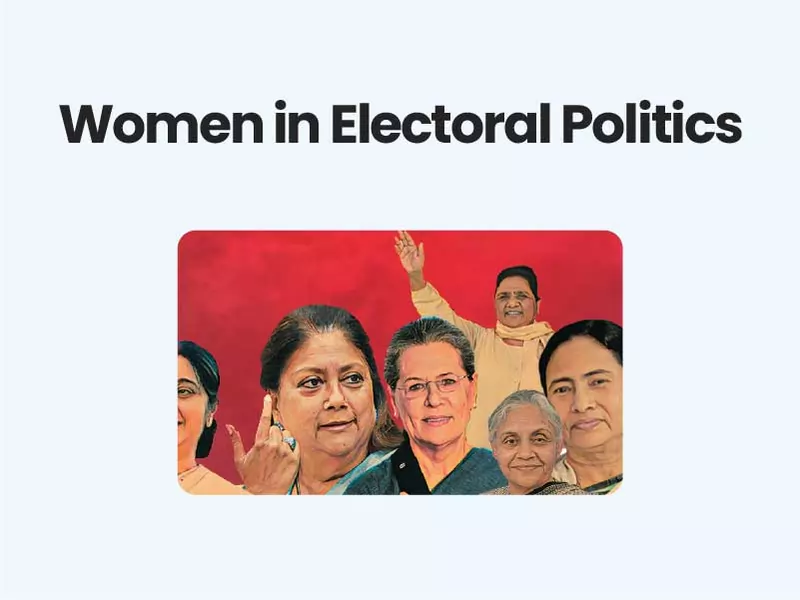Companion@360 → 7 Month programme to sharpen your writing skills → REGISTER NOW

Role of Women in Electoral Politics
The participation of women in politics not only comprises interactions in elections but also involves participation in trade unions, co-operatives, women’s collectives, informal and formal politics.
A historical overview of women’s rights generally and of participation in electoral competition both chronologically and thematically traces its origin to the Swadeshi movement in Bengal (1905–8), which marked the beginning of Indian women’s participation in nationalist activities and also brought the question of women’s suffrage and voting rights to the forefront .
Tracing the origins of the women’s suffrage movement in India, observes that the insistence of organised women to be treated as equals of men emerged not from perceptions of the needs of women in India but from the influence of certain British women.
Thus, the origins of the movement for women’s suffrage in India in the early twentieth century.
Significance:
- As an indicator of equality and freedom, it cuts across genders in sharing political power and providing liberty and space to women within the democratic framework of electoral politics.
- The 1950 Constitution of India promised in the Preamble to secure to all its citizens ‘JUSTICE, social, economic and political’, as well as ‘EQUALITY of status and of opportunity’ .
- Despite this clear-cut constitutional mandate for providing equality to women in the public domain, including electoral politics, prejudice and discrimination against women in India continue even after 70 years of independence.
- This opens up important debates on organising politics around difference ,The representation of women in the Lower House (Lok Sabha) of India’s Parliament does not at all mirror the gender demographics of the country.
- The presence of women after 15 Lok Sabha elections is still only a notch above the halfway mark of the world average of 22 per cent representation of women, with India ranked 141 among 193 countries (Inter-Parliamentary Union, 2016).
- India had 65 women out of 545 members of Parliament (MPs) elected to the 16th Lok Sabha in May 2014, for a 12% representation.
- Only the 15th and 16th Lok Sabha changed a previously stagnant representation of under 9% recorded by Indian women MPs since Independence.
- The 73rd and 74th amendments to the Indian Constitution reserve one-third of local body seats for women. Reservation for one-third of the seats for women in the Lok Sabha has been tabled as a bill several times until as recently as 2008.
- Women in India have largely failed to acquire the critical mass required to introduce gender perspectives in political decision-making processes at higher levels and to promote gender-friendly legislation .
- Similarly, the number of women representatives in most state legislatures in India remains below the world mark, indicating a pan-Indian pattern of gender exclusion in electoral politics, under-representation in legislative bodies and the necessity of continuing quests to achieve gender parity in sharing political power with men.
Challenges:
- Imbalanced representation of women
- Patriarchal and male dominated in nature
- Socio-Cultural factors:Cultural expectation about mother role are defined as ideal and expected of all women, these expectation tends overburden women.
- Religion
- Economic Factor
- Lack of Consensus
- Lack of intra party democracy
Which is the best test series for UPSC Check Now
Way Forward:
- Women’s should have equal rights with men in the political, social, economic and cultural spheres. Even though constitution guarantees women equal right in all spheres socio-cultural factors need to be adapted to modern ethos of equality.
- Both education and health are important for women to be able to play role in politics at local, state or central level.
- There is need to reinforce with in society and women about their right to property.
- Reform in electoral politics
- Social awareness campaigns
Initiatives of government for empowering women
- Mahatma Gandhi National Rural Employment Guarantee Act (MGNREGA)
- Swayam Siddha
- Scheme for Working Women Hostel
- STEP (Support to Training and Employment Programme for Women)
- Swarnjayanti Gram Swarozgar Yojana
- Sarva Shiksha Abhiyan
- Indira Gandhi Matritva Sahyog Yojana (IGMSY)
The political parties that played a destructive role in scuttling the Women’s Reservation Bill in the last Lok Sabha have become redundant after the general elections in 2014. The current government has given a positive signal for women-inclusive politics, providing six cabinet ministerial positions to women, raising hopes that it would build an all-party consensus and pass the long-standing Bill in due course.

